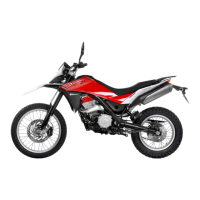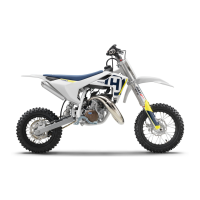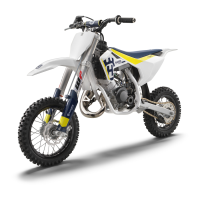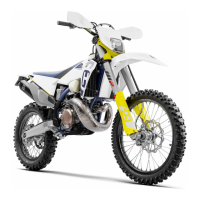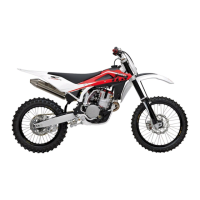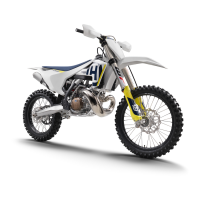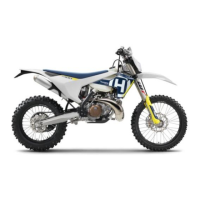Do you have a question about the Husqvarna TR650 STRADA and is the answer not in the manual?
Technical details and operational guidelines specific to the TR 650 Terra model.
Technical details and operational guidelines specific to the TR 650 Strada model.
Introduction to the Husqvarna motorcycle and the owner's manual.
Crucial information regarding warranty coverage and product usage.
Defines the designated purpose and operational scope of the motorcycle.
Provides general advice and best practices for operating the vehicle.
Guidance on attaching and using luggage accessories, including weight limits.
Precautions related to exhaust fumes and hot engine components.
Safety instructions for handling flammable fuel and hot coolant.
Guidelines for safe handling and proper disposal of engine oil.
Warnings about the corrosive nature of brake fluid and protective measures.
Safety advice for battery charging and handling its corrosive contents.
Details on the 17-digit VIN and where to find it on the frame.
Explains the model designation, year, and serial number coding.
Detailed data for engine, primary drive, transmission, and final drive ratios.
Specifications for suspension systems, brakes, and wheel dimensions.
Recommended tyre pressures and specified lubricants for various components.
An illustrated overview identifying major external parts of the motorcycle.
Detailed legend for handlebar switches, levers, and foot controls.
Step-by-step instructions for safely refuelling the motorcycle's fuel tank.
How to operate the side stand and associated safety warnings.
Identifies the location and purpose of various warning lights on the dashboard.
Explains the different display areas and their potential readouts.
In-depth explanation of what each warning light signifies.
Explains the 'ICE' indicator for low temperatures and the 'Service' indicator for maintenance.
Step-by-step guide to setting the motorcycle's clock time.
How to change display units for speed, distance, and temperature.
How to use and reset the trip meter for partial mileage tracking.
Details on displaying and resetting fuel consumption data.
Instructions for adjusting throttle and front brake lever positions for rider comfort.
Explanation of the three positions of the ignition switch and their functions.
Procedures for locking and unlocking the motorcycle's steering.
Operation of engine start and kill switches on the right handlebar.
Operation of turn signals, beam controls, and ABS switch on the left handlebar.
How to adjust the clutch lever and its related safety switch function.
Operation of the rear brake pedal and the gear shift lever.
Essential checks to perform before each ride for safety and readiness.
Guidelines and recommendations for the initial break-in period of the motorcycle.
Solutions for issues like engine not starting, rough running, or overheating.
Diagnosing problems related to power loss, engine knocking, and electrical systems.
Addressing difficulties with gear shifting and brake system issues.
Step-by-step instructions for the rider to safely mount and dismount.
Guidelines for passengers to safely board and exit the motorcycle.
Importance of ensuring a stable and level parking surface before dismounting.
Detailed steps for starting the engine, including safety switch functions.
Special precautions and recommendations for starting the engine in cold weather.
Essential checks before riding and adjusting mirrors for visibility.
Techniques for smooth gear changes and controlled acceleration.
Emphasizes protective gear, positioning, and passenger awareness for safety.
Adjusting speed based on road conditions, signs, and weather.
Proper methods for braking and downshifting to maintain stability and control.
Steps for safely slowing down and stopping the motorcycle.
Using the emergency stop button and critical brake usage warnings.
Information on the catalytic converter's role and heat-related precautions.
Detailed steps for checking the engine oil level accurately.
How to check the coolant level and add fluid if necessary, with safety warnings.
Instructions for inspecting, cleaning, or replacing the air filter element.
Procedure for checking the front brake fluid level and warnings.
Adjusting rear brake pedal play to prevent premature pad wear.
How to check the rear brake fluid level and related safety warnings.
Adjusting the clutch lever position to suit the rider's hand.
Adjusting the free play in the clutch lever for optimal operation.
How to adjust the rear shock absorber's spring preload for ride comfort.
Adjusting the rebound damping characteristics of the rear shock absorber.
Step-by-step guide to checking and adjusting the drive chain tension.
Inspecting the drive chain and sprockets for signs of wear or damage.
Maintaining tyre pressure and understanding the ABS system's function.
Identifying all parts of the front braking system, including lines, calipers, and discs.
Identifying all parts of the rear braking system, including reservoir, caliper, disc, and pedal.
How to check brake pad wear and identify the wear limit indicators.
Proper methods for cleaning brake pads and discs to maintain performance.
Step-by-step instructions for removing and refitting the motorcycle seat.
Guidelines for battery care, including charging and safety precautions.
Procedures for accessing and replacing the front headlamp bulb, including handling precautions.
Instructions for replacing turn indicator bulbs and the tail light assembly.
Steps for replacing the bulb for the number plate illumination.
How to properly aim and adjust the headlight beam for optimal visibility.
Identifying the main fuses, their ratings, and location on the motorcycle.
Explains the purpose of each auxiliary fuse and the electrical circuits they protect.
Steps for preparing the motorcycle for extended periods of inactivity.
Guidelines for cleaning the motorcycle, including precautions for different conditions.
Precautions to protect electrical parts and fuel injection system from water.
Instructions for drying brake components and restoring braking efficiency.
Details on the operational checks performed during pre-delivery inspection.
Technical details and operational guidelines specific to the TR 650 Terra model.
Technical details and operational guidelines specific to the TR 650 Strada model.
Introduction to the Husqvarna motorcycle and the owner's manual.
Crucial information regarding warranty coverage and product usage.
Defines the designated purpose and operational scope of the motorcycle.
Provides general advice and best practices for operating the vehicle.
Guidance on attaching and using luggage accessories, including weight limits.
Precautions related to exhaust fumes and hot engine components.
Safety instructions for handling flammable fuel and hot coolant.
Guidelines for safe handling and proper disposal of engine oil.
Warnings about the corrosive nature of brake fluid and protective measures.
Safety advice for battery charging and handling its corrosive contents.
Details on the 17-digit VIN and where to find it on the frame.
Explains the model designation, year, and serial number coding.
Detailed data for engine, primary drive, transmission, and final drive ratios.
Specifications for suspension systems, brakes, and wheel dimensions.
Recommended tyre pressures and specified lubricants for various components.
An illustrated overview identifying major external parts of the motorcycle.
Detailed legend for handlebar switches, levers, and foot controls.
Step-by-step instructions for safely refuelling the motorcycle's fuel tank.
How to operate the side stand and associated safety warnings.
Identifies the location and purpose of various warning lights on the dashboard.
Explains the different display areas and their potential readouts.
In-depth explanation of what each warning light signifies.
Explains the 'ICE' indicator for low temperatures and the 'Service' indicator for maintenance.
Step-by-step guide to setting the motorcycle's clock time.
How to change display units for speed, distance, and temperature.
How to use and reset the trip meter for partial mileage tracking.
Details on displaying and resetting fuel consumption data.
Instructions for adjusting throttle and front brake lever positions for rider comfort.
Explanation of the three positions of the ignition switch and their functions.
Procedures for locking and unlocking the motorcycle's steering.
Operation of engine start and kill switches on the right handlebar.
Operation of turn signals, beam controls, and ABS switch on the left handlebar.
How to adjust the clutch lever and its related safety switch function.
Operation of the rear brake pedal and the gear shift lever.
Essential checks to perform before each ride for safety and readiness.
Guidelines and recommendations for the initial break-in period of the motorcycle.
Solutions for issues like engine not starting, rough running, or overheating.
Diagnosing problems related to power loss, engine knocking, and electrical systems.
Addressing difficulties with gear shifting and brake system issues.
Step-by-step instructions for the rider to safely mount and dismount.
Guidelines for passengers to safely board and exit the motorcycle.
Importance of ensuring a stable and level parking surface before dismounting.
Detailed steps for starting the engine, including safety switch functions.
Special precautions and recommendations for starting the engine in cold weather.
Essential checks before riding and adjusting mirrors for visibility.
Techniques for smooth gear changes and controlled acceleration.
Emphasizes protective gear, positioning, and passenger awareness for safety.
Adjusting speed based on road conditions, signs, and weather.
Proper methods for braking and downshifting to maintain stability and control.
Steps for safely slowing down and stopping the motorcycle.
Using the emergency stop button and critical brake usage warnings.
Information on the catalytic converter's role and heat-related precautions.
Detailed steps for checking the engine oil level accurately.
How to check the coolant level and add fluid if necessary, with safety warnings.
Instructions for inspecting, cleaning, or replacing the air filter element.
Procedure for checking the front brake fluid level and warnings.
Adjusting rear brake pedal play to prevent premature pad wear.
How to check the rear brake fluid level and related safety warnings.
Adjusting the clutch lever position to suit the rider's hand.
Adjusting the free play in the clutch lever for optimal operation.
How to adjust the rear shock absorber's spring preload for ride comfort.
Adjusting the rebound damping characteristics of the rear shock absorber.
Step-by-step guide to checking and adjusting the drive chain tension.
Inspecting the drive chain and sprockets for signs of wear or damage.
Maintaining tyre pressure and understanding the ABS system's function.
Identifying all parts of the front braking system, including lines, calipers, and discs.
Identifying all parts of the rear braking system, including reservoir, caliper, disc, and pedal.
How to check brake pad wear and identify the wear limit indicators.
Proper methods for cleaning brake pads and discs to maintain performance.
Step-by-step instructions for removing and refitting the motorcycle seat.
Guidelines for battery care, including charging and safety precautions.
Procedures for accessing and replacing the front headlamp bulb, including handling precautions.
Instructions for replacing turn indicator bulbs and the tail light assembly.
Steps for replacing the bulb for the number plate illumination.
How to properly aim and adjust the headlight beam for optimal visibility.
Identifying the main fuses, their ratings, and location on the motorcycle.
Explains the purpose of each auxiliary fuse and the electrical circuits they protect.
Steps for preparing the motorcycle for extended periods of inactivity.
Guidelines for cleaning the motorcycle, including precautions for different conditions.
Precautions to protect electrical parts and fuel injection system from water.
Instructions for drying brake components and restoring braking efficiency.
Details on the operational checks performed during pre-delivery inspection.
| Displacement | 652 cc |
|---|---|
| Bore x Stroke | 100 mm x 83 mm |
| Fuel System | Electronic fuel injection |
| Transmission | 6-speed |
| Seat Height | 860 mm |
| Dry Weight | 168 kg |
| Starter | Electric |
| Final Drive | Chain |
| Cooling System | Liquid cooled |
| Rear Suspension | Monoshock |
| Front Brake | Single disc |
| Rear Brake | Single disc |
| Front Tire | 110/80 R19 |
| Power | 58 hp |
| Torque | 60 Nm |
| Engine Type | Single cylinder, 4-stroke |
